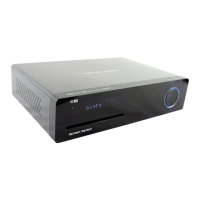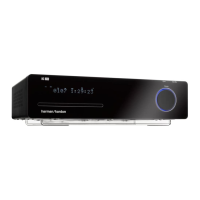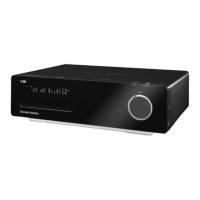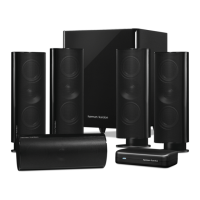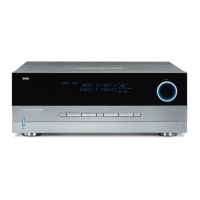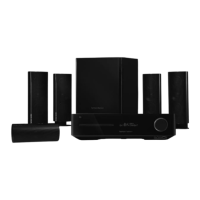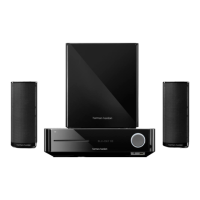TERMINOLOGY AND DVD BASICS 17
TERMINOLOGY AND DVD BASICS
Terminology
Since DVD players such as the one built into the
HS 100 share some of the characteristics and technol-
ogy of CD players, many of the terms and operational
concepts used to describe DVD playback are similar
to what you may be familiar with from CD players and
changers. However, if this is your first DVD product,
some of the terms used to describe the features of a
DVD player may be unfamiliar. The following explana-
tions should solve some of the mysteries of DVD, and
help you to enjoy all the power and flexibility of the
DVD format and the DVD.
Aspect Ratio: This is a description of the width of a
video image in relation to its height. A conventional
video screen is four units wide for every three units of
height, that’s why the ratio is called “4:3”. Newer wide
aspect ratio video displays are 16 units wide for every
nine units of height, making them more like the screen
in a movie theater. The program material on a DVD may
be recorded in either format and, in addition, you may
configure the DVD to play back in either format,
depending on the features recorded on a disc.
Title: For a DVD, a title is defined as an entire movie or
program. There can be as many chapters within a title as
the producers decide to include. Most discs include only
one title, but some may have more than one, to give you
a “Double Feature” presentation.
Chapter: DVD programs are divided into chapters and
titles. Chapters are the subsections programmed into a
single title on a disc. Chapters may be compared to the
individual tracks on an audio CD.
Progressive scan: DVD offers progressive scan video
outputs for use with compatible high-resolution televi-
sions and projectors. Before DVD, no consumer medium
could store, transmit or display video with full resolution.
To conserve bandwidth, analog compression (interlacing)
is employed: first the odd-numbered lines of a frame are
displayed, followed by the even-numbered lines. The
result is that only half of the video image is drawn at one
time; the viewer's brain must reassemble the complete
image. This is acceptable, if the monitor is not too large
and if there is not too much motion in the image. Large
displays and fast-moving images reveal the limitations
of this system. Thanks to DVD’s immense data capacity,
images may now be stored intact (progressively), so that
all the lines in each frame (odd and even) are shown at
the same time. But because older analog video displays
cannot handle a progressive signal, all current DVD
players generate an interlaced output for compatibility.
The HS 100 features true progressive scan video output
for use with compatible TVs and projectors and with all
“digital-ready” and high-definition display devices via the
component video output. The result is 40% greater light
output than a conventional TV and a stunningly detailed
high definition image, along with an almost complete
absence of visible scanlines and motion artifacts. Of
course, traditional Y/Pr/Pb component video, S-video
and composite video outputs are also available for use
with conventional televisions and projectors.
Multiple Angle: DVDs have the capability to show up
to four different views of the same scene in a program.
When a disc is encoded with multiple-angle informa-
tion, pressing the Angle button will enable you to switch
between these different views. Note that at present, few
discs take advantage of this capability and, when they
do, the multiple-angle technology may only be present
for short periods of time within the disc. Producers will
usually insert some sort of icon or graphic in the picture
to alert you to the availability of multiple viewing angles.
Reading: This is a message that you will see after
you’ve loaded the disc and the tray has closed. It refers
to the fact that the player must first examine the con-
tents of the disc to see whether it is a CD or DVD, and
then extract the information about the type of material
on the disc, such as languages, aspect ratios, subtitles,
number of titles and more. The slight delay while the
contents of the disc are read is normal.
Resume: The operation of the Stop Button on the DVD
works differently from what you are used to on CD
players. On a traditional CD player, when you press the
Stop button, the unit does just that – it stops playback.
On a CD player, when you press the Start button again,
the disc starts from the beginning. With the DVD, how-
ever, you have two options when playing DVD discs.
Pressing Stop once will stop playback, but it actually
puts the unit in the Resume mode. This means that you
can turn the machine off and, when you press Play the
next time, the disc will resume or continue from the
point on the disc where the Stop button was pressed.
This is helpful if you are watching a movie and must
interrupt your viewing session but wish to pick up
where you left off. Pressing the Stop button twice will
stop the machine in a traditional manner and, when the
disc is played again, it will start from the beginning.
DVD Basics
• The types of functions and operations that can be
used for a particular disc vary depending on the
features of that disc. In some cases, these functions
and operations may differ from the descriptions given
in this manual. In this event, follow the instructions
given on the screen. This manual only covers basic
disc operations.
• For some operations, the icon may appear on
the screen. This indicates that the operation described
in this manual is not available on the disc currently in
the player.
Disc Handling Precautions
• To keep the disc clean, handle the disc by its edge.
Do not touch the surface.
• Do not stick paper or tape on the disc. If there is glue
(or a similar substance) on the disc, remove the glue
completely before using the disc.
• Do not expose the disc to direct sunlight or sources
such as hot air ducts, or leave it in a car parked in
direct sunlight, as there can be a considerable rise in
temperature inside the car.
• After playing, store the disc in its case.
• Do not write on the label side with a ball-point pen or
other sharp writing utensils.
• Be careful not to drop or bend the disc.
Disc Cleaning Precautions
• Before playing, clean the disc with a cleaning cloth.
Wipe the disc from the center out.
• Do not use solvents such as benzine, thinner, com-
mercially available cleaners or anti-static spray
intended for vinyl LPs.
Disc Loading Precautions
• Do not load more than one disc on disc tray.
• Do not place a disc on the tray upside down.
• Do not try to close the disc tray when the disc is not
positioned or centered properly.
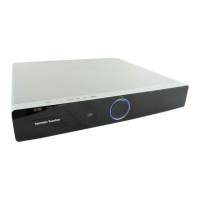
